Table of Contents
The New Universal Search Results
Since June of 2007, Google has been showing Universal Search Results. These are sometimes referred to as “Blended Search” or “Enhanced Search”. Before Google added the name “Universal Search,” I remember talking about “Vertical Creep into Organic Results,” and how Google was experimenting with adding results for different Vertical searches into the 10 Blue links they had been showing in response to queries.
Related Content:
Organic Results under Universal Search have included Images, Videos, News, and Maps results. And we have been seeing more types of results appearing in Organic Search Results, such as People Also Search For Questions, Knowledge Cards, Answer Passages for Featured Snippets, These new types of results appear to be a mix of knowledge type results.
Google recently added some icons related to the different types of search that they provide across the top of the search results page (seen in the image above)(. There are separate icons for things such as Shopping, Books, News, Images, Maps, Videos, Flights, and Finance. There is no “Web” Icon, but instead, the First one show is an “All” icon. That sounds like the “one simple set of search results” that was envisioned under Universal Search.
Earlier this month. Google came out with a continuation version of their Universal Search Results Patent. It is the fourth version of the patent that was originally filed on December 31, 2003. The claims listed in the last three versions of the patent have been updated in a few different ways that reflect changes in what we see in Universal Search Results at Google.
The Original Universal Search Results
Before I go into the changes in the Claims sections of the patents, it is interesting to learn more about the story of how Marissa Mayer originally invented Universal Search Results at Google, which she told in a Google Blog post that she wrote introducing it:
Universal Search: The Best Answer is Still the Best Answer by Marissa Mayer, where she says about Universal Search:
With universal search, we’re attempting to break down the walls that traditionally separated our various search properties and integrate the vast amounts of information available into one simple set of search results.
This patent (first filed in 2003) appears to be in response to criticisms like the one filed by Danny Sullivan in 2003 in the post Searching With Invisible Tabs. It appears that Google was introducing a lot of vertical searches, accessible by a growing number of tabs that people weren’t clicking upon. In that article, Danny offers the following suggestion:
The solution to tab blindness is clearly for me and an army of other search educators to head out and teach people how to use tabs! Naturally, that’s not going to happen. No, the solution is for the search engines to make use of “invisible tabs,” where they make the correct choice for the user, behind the scenes.
Marissa Mayer tells us that she started working on what became Universal Search in 2001, and Google’s patent for Universal Search Results was filed on December 31. 2003 – the same month as Danny’s article. There have been some criticisms of Google, and it’s habit of linking “to its own properties.” in its search results in recent years, but it does appear that they aren’t doing this as a way of keeping people on their own pages, but rather because of criticisms like those that pointed out that people often wouldn’t click on a growing number of tabs above Google’s search results. Having one set of “All” results is the point behind Universal Search.
New Universal Search Results
The latest version of the Universal Search Results patent from Google can be found at:
Interface for a universal search
Inventors: Bret S. Taylor, Marissa Ann Mayer, Orkut Buyukkokten
Assignee: Google LLC (Mountain View, CA)
US Patent: 10,409,865
Granted: September 10, 2019
Filed: April 15, 2016
Abstract
A search engine may perform a search for a user search query over several possible search categories. For example, the search query may be performed for general web documents, images, and news documents. The search engine ranks categories based on the search query and/or the documents returned for each category and presents the search results to the user by category. Higher ranking categories may be presented more prominently than lower-ranking categories.
What has changed with Google’s New Universal Search Results?
The description and summary of the patent haven’t changed from earlier versions – it is the claims that have been changing in newer versions. Claims are the things that prosecutors from the patent office focus upon to decide whether or not they will grant or deny a patent that has been filed. These are continuation patents because they take on the “file date” of the very first version, December 31. 2003. If they are granted it is because of the updated claims in them, and what those cover.
Looking at how those claims have changed over versions of Universal Search patents to reflect how the process behind Universal Search at Google has changed is interesting. I’m seeing two main differences over the years. The latest is how many results from different categories of results might be shown. The second is that the categories that were listed in the first version of Universal Search were removed and are no longer itemized like they were at first.
The New Universal Search Results Claim
The new change here, in the first claim listed, is that the most relevant and first listed category has more results shown from it than less relevant categories.
1. A computer-implemented method comprising: receiving a search query; obtaining data indicating multiple sets of resources responsive to the search query, each of the multiple sets of resources being classified as corresponding to a different category of resources; determining a relevance score for each of the different categories, the relevance score for each category indicating relevance of the set of resources corresponding to the category with respect to the search query; and providing, in a response to the search query, a search results page that presents search results identifying resources from the multiple sets of resources, including: organizing the search results for display such that search results corresponding to different categories are provided in respective areas that have locations determined according to the relevance scores for the different categories that indicate relevance of the respective sets of resources with respect to the search query; and including, in the respective areas provided for each of two or more of the different categories, search results that are relevant to the two or more different categories, wherein a second most relevant category has fewer search results presented in the search results page than a most relevant category based on the most relevant category being more relevant to the search query than the second most relevant category.
An Older Universal Search Results Claim Change
I’ve copied the first claim from the last version of the Universal search patent, which you can compare to the one above to see that it doesn’t tell us that results in the second category would have fewer search results than the first and most relevant category.
Interface for a universal search
US Patent: 9,342,563
Granted: May 17, 2016
Filed: May 29, 2015
1. A computer-implemented method comprising: receiving a search query; identifying a first set of documents that are each (i) responsive to the search query, and (ii) classified as belonging to a first category of documents; identifying a second set of documents that are each (i) responsive to the search query, and (ii) classified as belonging to a second category of documents; determining a relevance of the first set of documents relative to the second set of documents based on (i) a relevance of the first category to the search query, and (ii) a relevance of the second category to the search query; determining a layout of a search results page in which references to one or more documents of the first set and references to one or more documents of the second set are to be presented based on the relevance of the first set of documents relative to the second set of documents, comprising determining a size of a first area of the search results page in which the references to one or more documents of the first set are to be presented, and a size of a different, second area of the search results page in which references to one or more documents of the second set are to be presented; and providing, for display, the search results page having the determined layout.
Types of Categories identified in the Claims from the First Version of the Universal Search Patent
I then wanted to check the claims to see if they covered the kinds of categories that Universal Search Results contained, and only the first version of the patent listed categories of search results. The newer versions of the patent didn’t provide an itemized list as the first one did. It seems like they might have done this on purpose to give them the freedom to decide whatever categories they wanted to include in search results. The earliest version of the Universal Search patent can be found at:
Interface for a universal search engine
US Patent: 7,447,678
Granted: November 4, 2008
Filed: December 31, 2003
These claims from the first version of this patent shows off the categories that the patent covered initially:
9. The method of claim 1, where the document categories include at least one of a news category, an image category, or a product category.
10. The method of claim 1, where the document categories include a general web page category.
In the second version of the patent, that claim itemizing categories for Universal Search was removed, and it didn’t reappear on the third or the latest version of the patent either. And Universal results have had several additions as well.
What the New Universal Search Results Look Like
I just searched Amazon to see what the universal search results it contained included, and the results that were returned did include some different categories:
1. Knowledge Panel to the right of the main search results
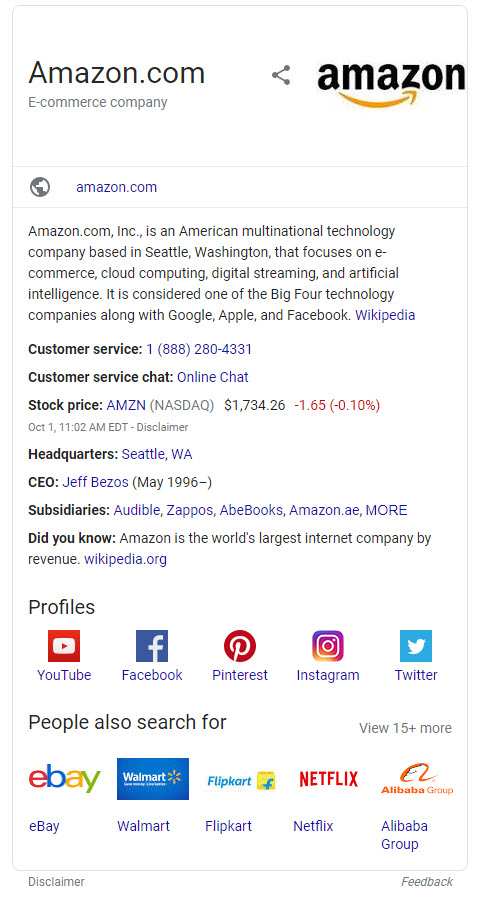
2. Web Results with Sitelinks for First Result
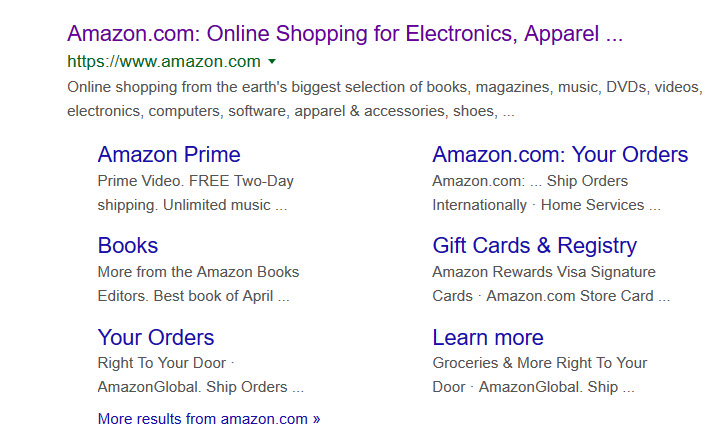
3. Twitter Results
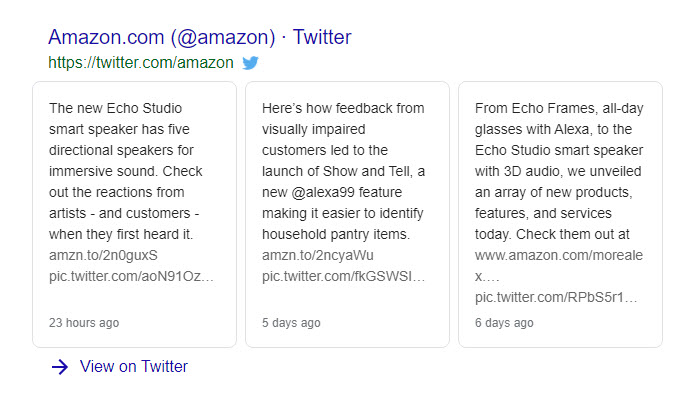
4. More Web Page Results
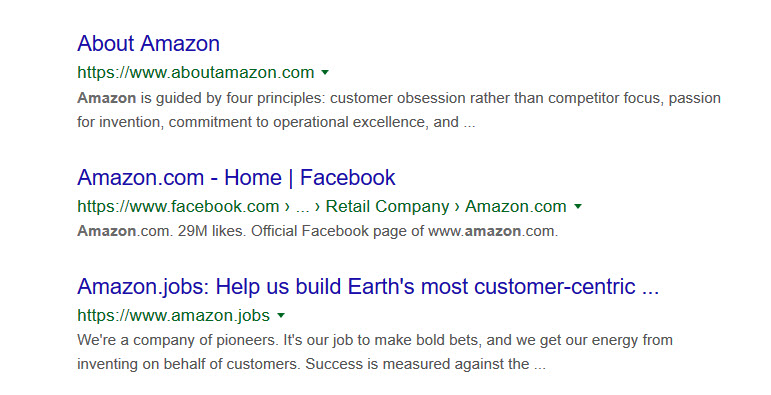
5. People Also Ask Questions
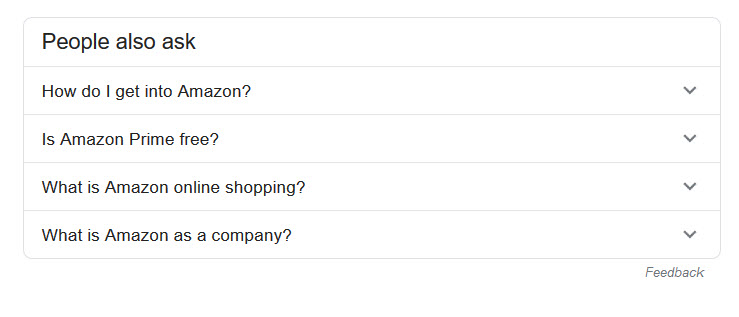
6. Top Stories (news)
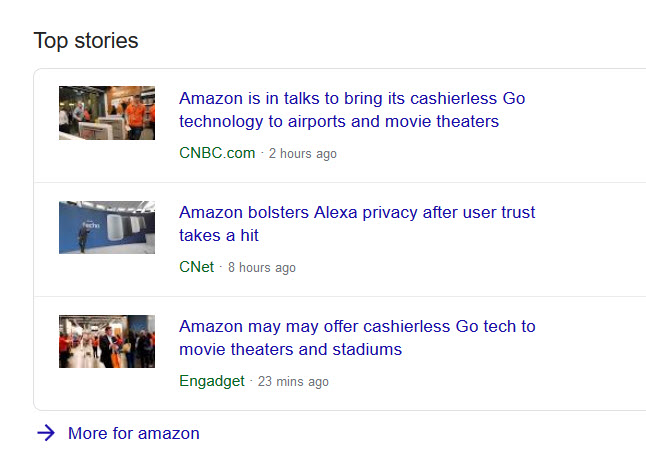
7. A Structured Snippet Search Result

8. Similar Entity Carousels

These results do look a lot different than the Universal Search Results that we have become accustomed to. There also isn’t a featured snippet on a search for [Amazon] which frequently shows in search results, like answer boxes used to that would show up showing a mix of results that would include local, news, and answers as well.
Google’s Universal Search patent looks like it expires in 2025. That doesn’t prevent Google from continuing to show Universal Search Results, but it limits other search engines from showing Universal Search Results that are similar to what Google is showing. Other Search engines have developed their versions of Universal search that don’t necessarily look that different from what Google offers presently. I expect how it looks to continue to evolve, perhaps including more data and knowledge-based features.
Search News Straight To Your Inbox
*Required
Join thousands of marketers to get the best search news in under 5 minutes. Get resources, tips and more with The Splash newsletter: